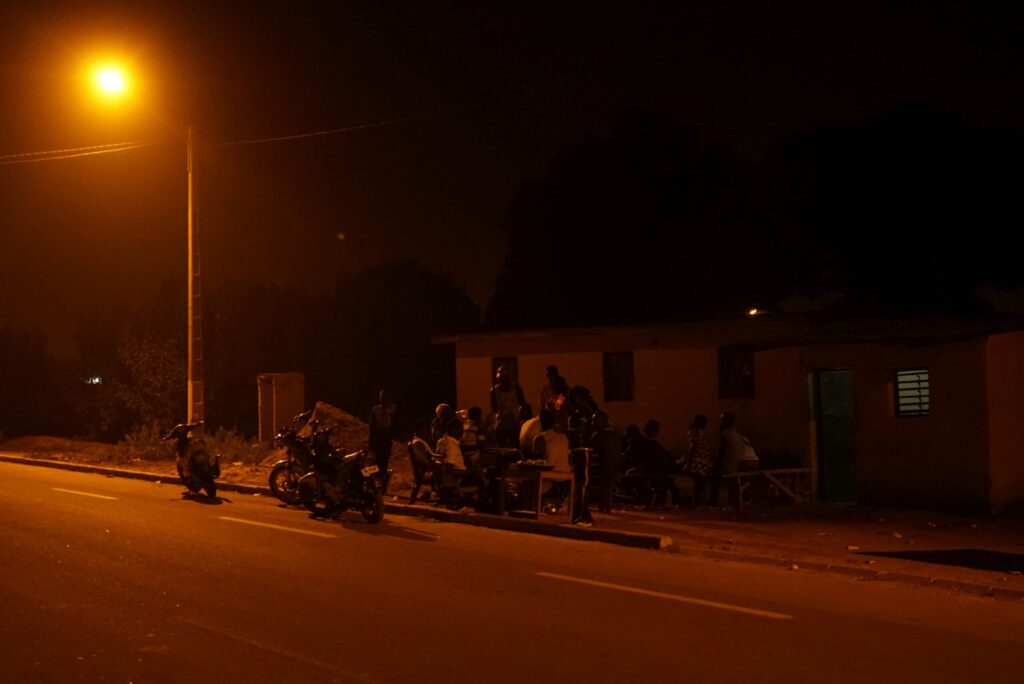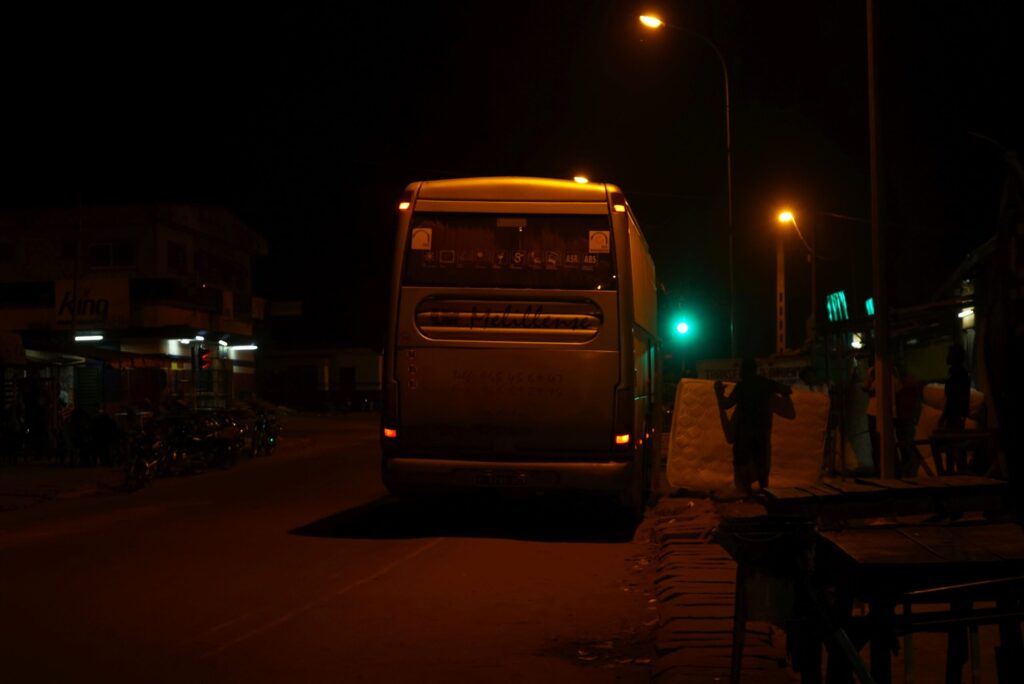‘I arrived in the provincial town of Odienné (Ivory Coast) by truck after a three-hour journey on unlit sandy roads across the bush. We first saw a few dots of light from afar; after a curve, we then saw a unique street lighting revealing silhouettes of men carrying assault rifles.’
This is the beginning of the story André Chappatte, a swiss anthropologist who has worked in Africa for many years, told us at the 7. Berliner Nachtung. We have met at the Bullmiller Collection Studio for Islamic Art in Berlin Kreuzberg, an atmospheric location for a talk about the perception of the night in Ivory Coast, also known as Côte d’Ivoire. It is a story about night and light, about darkness and shadows, about mysteries, and about the idea of the forbidden. It is a magical story.
And it begins in a rather unmagical place, the Touba’s Corridor Checkpoint in Côte d’Ivoire at 5 am. Orange lights keep the darkness away from the soldiers checking the car. It is one of four checkpoints to enter Odienné, a town in the Northwest of Côte d’Ivoire. Côte d’Ivoire, so André Chappatte, is a soft power in Western Africa, with a strong economy and lots of cultural development, including a breakdown of traditions on one side and the emergence of new cultural traits on the other. Odienné, though a rather small town, is known as the President’s town, because it’s his mother’s hometown.

André Chappatte, researcher at the Leibniz-Zentrum Moderner Orient (ZMO) in Berlin, has chosen Odienné for his research on night life. He could have chosen a big city like Abidjan, the economic capital of Côte d’Ivoire, but André Chappatte is not so much interested in the big centres. He wants to study the remote places. Odienné is a clear contrast to the surrounding villages in terms of culture and civilisation. While most villages are still lit by single light bulbs connected to a solar panels, Odienné’s has invested lots of money in its street lights, which are fed by a power plant. Therefore, Odienné has a every-night life.
‘People don’t talk about their night life’, says the anthropologist, ‘they don’t give interviews. You need to experience it yourself.’ So he did, equipped with camera and microphone, and he presented his experiences in a mix of photographs, short films and stories about the people of Odienné.
Odienné at night is different from Odienné at day. Softer, more inviting. The combination of darkness and soft street lights hides many unattractive places like a rubbish tip. So darkness becomes a hiding place for the ugly, while lights are used to show the things we are proud of and want to see. This is the aesthetic function of light. But it also enables us to use our eyes at night. However seeing at night, or better the use of all our senses at night is a very different thing from our senses during the day. And this is what makes night such a special place.
The probably most important thing about night life is that at night, people do different things than during the day. Which, according to André Chappatte, is related to the fact that our senses work differently at night. Light is scarce and never nearly as bright as during daytime, especially not in a place like Odienné , where streets are illuminated by orange HPS lights instead of flashy cold-white LEDs. Our vision weakens, while our other senses, hearing, smelling, touch, andto a lesser extent, taste, become sharper. We rely on a combination of all these senses. We might hear a car approach from afar, but we don’t know the driver. Thus the street lights create a feeling of mystery. ‘The proximity in urban night is perceived as a shadow play’, André Chappatte says, ‘our mind becomes more sensual’.

At night, all our sense become numbed and sharpened at the same time. For most of us, night is associated with fear and the forbidden. But this numbness and sharpness of senses also offers possibilites. In Odienné, nights have a characteristical quietness, even when a large group of people comes together to celebrate. The sense of touch strengtens, and the border between inside and outside of our world is not as clear at night as during daylight, because te power of sight is reduced. We experience the feeling of vulnerability, but not necessarily in a bad way. The night brings privacy, sensuality, and cognitive withdrawal, it allows us to do forbidden things in the dimmness of weak light. We use sense and sensibilty as a guide through the world. Chappatte’s vulnerability is not a weakness, but an exposure to an experience beyond the control of cognitive faculties. The magic of night is that it invites humans to inward sensual experiences without forcing itself on us.
Whether you accept this invitation and how you experience the night depends on how you are brought up to it. Some people see the night as a time for celebration, for dancing, and joy. Other use nighttime as a retreat from the busy day. They choose the time of night for prayers, as Chappatte shows in a short film about a man who gets up at 1 am to pray until the morning. He chose this time because his family is asleep and he can immerse himself into the prayers without being disturbed.
And there are those who exclude themselves from the night by going to bed early. They often have a perception of the night as a time for the forbidden, for sex, alcohol, and drugs. A perception formed by the fact, that they never have experienced the night.
Whatever a person’s feeling about the night might be, André Chappatte believes that ‘it is impossible to domesticate the night through artificial light’. Let’s hope he is right and we will keep this wonderful mystery in our lifes.
For those of you who want to know more about the shadowplay of the night and the distance receptors, Andrè Chappatte has two book suggestions:
Tanizaki: In praise of shadows. It’s an essay by the Japanese novelists on the role of shadows in Japanese culture
Edward T. Hall: The Hidden Dimension. A book about proximity, the ‘territory’ and how our use of space shapes societies.
